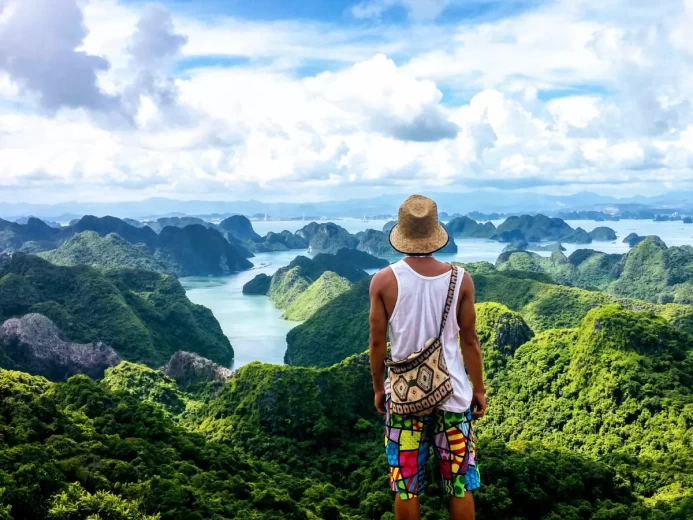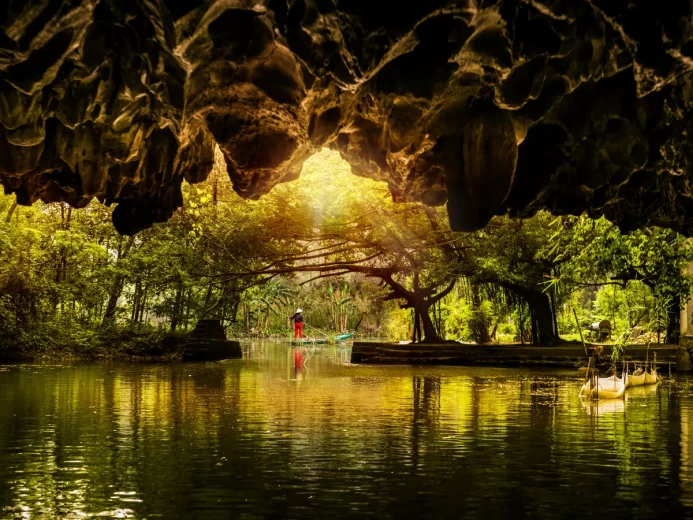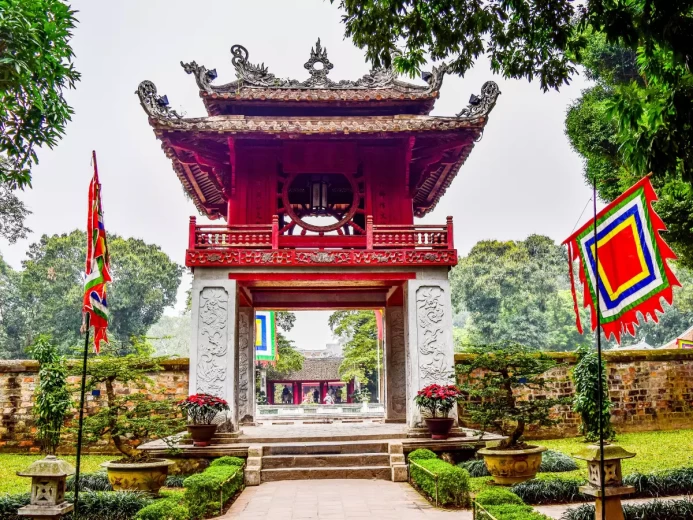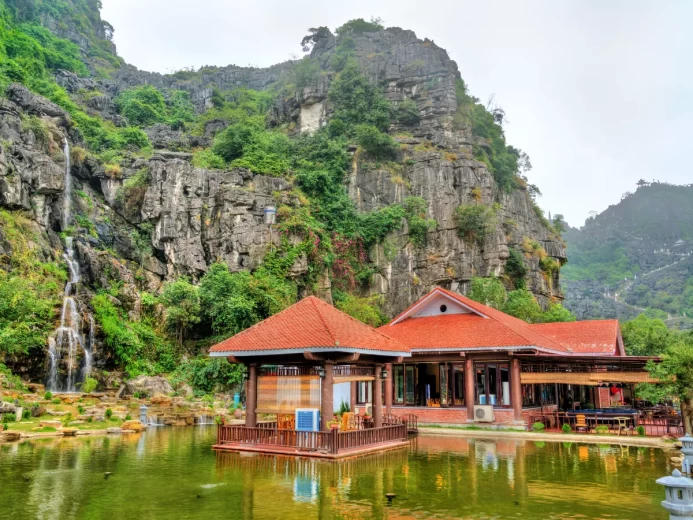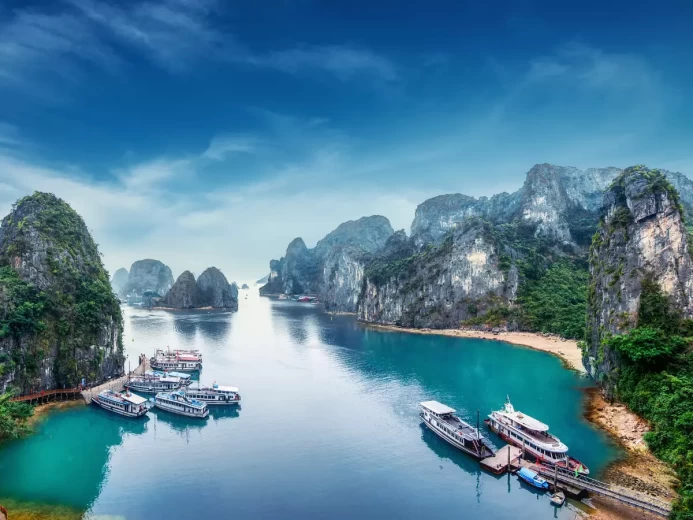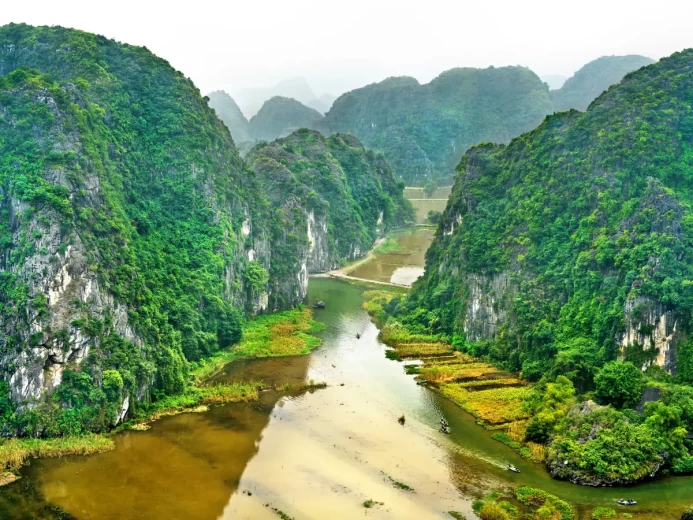About City
Hanoi
Perched on the banks of the Red River, Hanoi is Vietnam's capital and one of the world's most ancient cities. Boasting well-preserved colonial buildings, golden pagodas, unique museums, mouthwatering cuisine, entertainment destinations, and traditional bazaars, Hanoi is a melting pot of French, Chinese and Southeast Asian cultures.
Hanoi has an impactful history. The most incredible places of historical and cultural interest in Hanoi are the UNESCO-listed Thang Long Imperial Citadel, Vietnam's administrative centre for 800 years, Ho Chi Minh Mausoleum, where his body is preserved, Perfume Pagoda and Relic. Packed with courtyards and Parisian-style buildings, Old Quarter and French Quarter are affluent, enigmatic areas. Bach Ma Temple, Tran Quoc Pagoda, Hoan Kiem Lake's softshell turtle safaris, and Lake of Restored Sword offer a reprieve from the urban humdrum.
It is a misconception that Hanoi is conservative. From Dong Xuan Market housing Louis Vuitton and irresistible street food to the 65 glam floors of Lotte Tower Observation Deck, Hanoi flaunts glitzy nightlife and shopping districts. With its balustrades and Gothic domes, monks practising Tai Chi, cobbled riverside streets, tube houses, farmers' markets, rich culture and much more, Hanoi defines the war-stricken past and the resilient awakening of Vietnam.
Things To Do In Hanoi
1. Old Quarter
Old Quarter in Hanoi, also known as the Hoan Kiem District or simply 36 Streets, is one of the oldest neighbourhoods in Hanoi. It is home to the most popular hotels, historical attractions, tourist street shops and cafes in Hanoi. Here, among the most popular things to do are sampling the delectable street food, visiting the Hoan Kiem Lake, observing the olden architecture and shopping at the Hanoi Weekend Night Market. To fully experience the Old Quarter in Hanoi in the best way, it is best to walk.
2. Hoan Kiem Lake
Hoan Kiem Lake is a serene spot in Hanoi, ideal for unwinding after a long day. Surrounding the Ngoc Son Temple, with its iconic red bridge, it paints a pretty picture. On the northern shore is a small island where the Ngoc Son temple is located.
3. Imperial Citadel of Thang Long
The Imperial Citadel of Thang Long, also known as the Hanoi Citadel, is a UNESCO world heritage site, home to a number of artefacts that signify the historical and cultural importance of Vietnam and its history. The site was excavated in 2014 and a number of Bronze coins, ceramics, pottery, foundations of old roads, palaces, wells as old s 6th Century were discovered. The Citadel also served as the political centre of Vietnam for 13 consecutive years.
4. Temple of Literature
The Temple of Literature, also known as Van Mieu, is an 11th-century Vietnamese temple dedicated to Confucius. Built in 1070 by Emperor Ly Thanh Tong, the temple features picturesque pavilions, halls and statues surrounded by scenic ponds and gardens.
5. French Quarter in Hanoi
The French Quarter in the old part of Hanoi is a relatively affluent neighbourhood of the city. Located southeast of Hoan Kiem Lake, this area is home to many commercial establishments and government buildings as well. Many buildings and streets showcase the architectural influence of the French, especially in the French-styled villas. The French Quarter neighbourhood also houses many luxury hotels, fine dining restaurants and even boutiques, cafes, bookstores and more.
6. Lotte Observation Deck
Undisputedly the best viewing point in the city, the Lotte Observation Deck, located on the 65th floor of the Lotte Centre, provides a stunning panoramic view of Hanoi. The floor-to-ceiling glass and scopes make the experience even better, and one can even go in for some refreshments at the many food joints available.
7. Thang Long Water Puppet Theater
The Thang Long Water Puppet Theatre is the best place to witness the eponymous art form integral to the country. The Vietnamese tradition of water puppetry dates back to the 11th century when the rice fields got flooded and the villagers made entertainment by standing in water with puppets.
8. Hanoi Opera House
Hanoi Opera House, located near the Hoan Kiem Lake is Hanoi, was built in 1911 by the French and mimics the Paris Opera House in its structure and interiors.
9. One Pillar Pagoda
One of the most iconic temples of Vietnam, the One pillar Pagoda is one pillar built elegantly in the shape of a lotus blossom which is the Buddhist symbol of enlightment. The shrine inside the Pagoda is dedicated to the vietnamese Buddhist deity Quan Am. Built in the year around 1050 during the reign of the Ly Dynasty, this temple is said to bring blessings of fertility and health.
10. Presidential Palace
Presidential Palace of Hanoi is located in the Ba Dinh District of Hanoi at Hung Vuong St. and Hoang Van Thu St. Constructed in 1900, the Presidential Palace of Hanoi was originally intended to be Ho Chi Minh's official residence. At present, tourists are not allowed to enter the interiors of the building.
11. Ho Chi Minh's Stilt House
The humble abode of one of the most important political figures in Vietnamese history, President Ho Chi Minh's Stilt house is a must-visit while visiting Hanoi. The two-bedroom house is surrounded by a carp pond, and still contains his personal typewriter and armchair. Its sparse furnishings are an ode to the simplicity of the man who lived there.
12. Vincom Mega Mall Royal City
The Royal City Vincom Mega Mall is a beautifully built structure with a slight touch of Greek architecture to it. This mall is one of the most visited destinations in Hanoi and lies 45 minutes from the centre of town. With a modern and luxurious rich setup, this two storied building is home to a number of retail shops, food joints, especially like the ice-skating rink.
13. Vinpearl Aquarium (Times City)
Vinpearl Aquarium is the largest, most modern and the first underground aquarium in Vietnam situated in the Vincom Mega Mall Times City. With a capacity of 3 million litres of water, this aquarium is home to thousands of sea species. Some rare creatures here are penguins, otters and seacows. Families and those interested in learning about some gorgeous marine ecosystem should head here.
14. Ba Vi National Park
Nestled at the centre of three mountains summits, the Ba Vi National Park lies about 63 km away from Hanoi and can be reached by public as well as private transport. So stunning is the beauty of this place that it was used as a hill station by the French. Some of those resort ruins can still be seen scattered across its landscape.
15. Hoa Lo Prison Museum
Hoa Lo Museum is all that remains of the Hoa Lo Prison, which was used to capture Vietnamese and American political prisoners during the colonial period and the Vietnam war respectively. It is located in the Hoan Kiem area. The interrogation room, guillotine and John McCain's suit all are on display, a silent reminder of gruesome past Vietnam has had to witness.
16. Vietnam Museum of Ethnology
The Vietnam Museum of Ethnology is a great place to explore the socio-cultural diversity of Vietnam. Built in 1995, the museum prides itself on housing and displaying relics of the South-East Asian culture. It exhibits artefacts from the daily lives of the 54 officially recognized ethnic groups, including photographs, audiotapes, antiques and everyday objects such as baskets and knives. Information regarding the rituals and ceremonies of each group are also displayed, while the outdoor area houses replicas of Vietnamese homes.
17. Ho Chi Minh's Mausoleum
The Ho Chi Minh Mausoleum, located in Ba Dinh Square, is the final resting place of the most popular leader of Vietnam, Ho Chi Minh, known to his people as Uncle Ho. It is also where Uncle Ho read the Declaration of Independence on September 2nd, 1945. It was opened to the public in 1975. Visitors are allowed a short time to look at the casket as the line has to keep moving forward.
Nightlife in Hanoi
While most clubs, bars and pubs are supposed to shut down at midnight, Hanoi's nightlife has more to offer well after the clock strikes twelve. Street food markets line the public roads offering delectable food and cold beer to thousands of hungry patrons. After sundown, the night markets also see large crowds vying for clothes, accessories, electronics and other knick-knacks. There are three major areas for those seeking crowded gatherings at night - The Bia Hoi Junction in the Old Quarter, The West Lake Area and the Historical Center. For those who wish to avoid the crowds, the Opera House, Hanoi Central Circus or Water Puppet Theatre are great alternative experiences.
Shopping in Hanoi
Shopping in the capital city of Vietnam is a homecoming experience in itself. From local street markets to world-class malls, Hanoi is undoubtedly a shopper's paradise. While the shopping malls and street markets are the most popular spots to head for some shopping, the city's traditional clothing and handicraft establishments are equally worth visiting. For those looking for beautiful ceramic and porcelain items, Bat Trang Village is the place to be. Visitors to the village can also enjoy pottery and ceramic craft workshops.
Casinos in Hanoi
An essential experience of Hanoi is the vibrant casinos of the city. Indulge in a game of blackjack, Roulette, Poker or Baccarat in some of the best casinos. Some casinos also offer business spaces to work along with some play should patrons require such amenities. The casinos are primarily located at high-end hotels in Hanoi, and there are no individual casinos in Hanoi.
How To Reach Hanoi
From India
Hanoi houses a personal international airport of its own, Noi Bai International Airport with several direct flights flying to and from India. There are many flight services that ply on regular basis including Air India, Malaysia Airlines, VietJet Air, Thai Airways, Singapore Airlines, Jet Airways, China Southern and others from various India cities such as Delhi, Mumbai, Bangalore, Aurangabad, Goa and Ahmadabad etc.
By road
Self-driving in Vietnam is not quite recommended, owing to the less than ideal state condition of the roads and often confusing and lax traffic rules. It is better to hire a taxi or take a chauffeur-driven car to commute within the city or between the cities.
By train
Gia Lam station serves as the main railway station for Hanoi city and has a single route for trains departing to and from Nanning, China. There is a line between Ho Chi Minh City and Hanoi, the journey being quite inexpensive and packed with scenic views. However, a Vietnam railway is not high on speed and so the journey takes 50 hours to complete.
By bus
Hanoi has several bus stations with each one serving a distinct destination. The buses at Gia Lam bus station on Ngo Gia Kham depart for Halong Bay and Haiphong. The buses departing for northwest Vietnam including Dien Bien Phu start from Kim Ma bus station, Nguyen Thai Hoc. One can board bus for towns south of Hanoi, including Ho Chi Minh City from Giap Bat bus station on Giai Phong.
Best Time To Visit Hanoi
The best time to visit Hanoi is from February to April and from Late September to November. February to April marks the time of spring and the days are warm and sunny. Rainfall is minimal with the usual drizzles. Temperatures hover from 20°C to 30°C. From Late September to November, the temperatures are quite similar to February till April, but you can expect temperatures to drop below 20°C in the evenings and at night.
Hanoi in Peak Season
The spring season, from February to April along with the fall season from October to November are considered to be the peak seasons and also the best time to visit Hanoi.
From February to April the city is not too hot and exploring the many beautiful tourist sites of the city can be undertaken with ease. By the end of February, the chill is beginning to give way to a mild, pleasant dry climate. The average temperature ranges from 15-20 degrees Celsius, and it is also the perfect time for the fields and plants to blossom, giving way to beautiful rural and natural landscapes.
Locals and tourists alike, wait for October. The constant rains during the summer months of May-September give way to one of the best seasons to travel to Hanoi. The average temperature is about 25 degrees, and the cold air and warm sun make for the ideal weather — the landscape changes to hues of yellow and golden that are splendidly scattered throughout the terrain. The fall also brings with it, bright blue skies.
Hanoi in Off Season
The summer months from May-September, which are also the official monsoon months of Hanoi and the winter months from December-January, are considered off seasons for tourists. The summers are scorching with temperatures hovering around 33 degrees. Heavy rains are frequent during the summers, which may range from slight drizzles to thunderstorms. Due to the high humidity accompanied by the precipitation, the summers are not the best time to venture into the outdoors. However, it is an excellent time to stay in the air-conditioned malls, enrol in cooking classes or jump into the swimming pool.
The winter months of December and January witness temperature dropping to 10 degrees Celsius. The winter temperatures give way to sunny, warm weather that one relates to many Southeast Asian cities.
Hanoi is different in that sense because its winters can get cold. With high humidity and windy conditions, the cold only increases. The day temperature may max out at 20 degrees and getting outdoors with warm clothing is a must. Compared to summers, winters are far more manageable and do see an influx of more tourists in comparison. The winter holiday season is a busy time and making bookings in advance is advisable.

